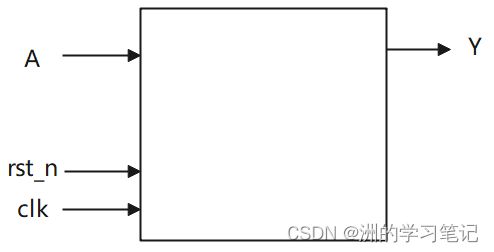【Verilog刷题篇】硬件工程师从0到入门3|组合逻辑复习+时序逻辑入门
Verilog从0到入门3-组合逻辑复习+时序逻辑入门
- 前言
- Q1:数据选择器实现逻辑电路
- Q2:根据状态转移表实现时序电路
- Q3:根据状态转移图实现时序电路
- Q4:ROM的简单实现
- Q5:边沿检测
- 总结:小白跟大牛都在用的平台
前言
- 硬件工程师近年来也开始慢慢吃香,校招进大厂年薪总包不下30-40w的人数一大把!而且大厂人数并没有饱和!
- 本期是【Verilog刷题篇】硬件工程师从0到入门3|组合逻辑复习+时序逻辑入门,有不懂的地方可以评论进行讨论! - 推荐给大家一款刷题、面试的神器,我也是用这一款神器进行学习Verilog硬件代码的!
- ~链接如下:刷题面试神器跳转链接
- 也欢迎大家去牛客查看硬件工程师招聘职位的各类资料,并进行提前批投递面试!
- 小白新手可以通过该神器进行日常的刷题、看大厂面经、学习计算机基础知识、与大牛面对面沟通~ 刷题的图片已经放在下面了~
Q1:数据选择器实现逻辑电路
问题描述:请使用此4选1数据选择器和必要的逻辑门实现下列表达式。
L=A∙B+A∙~C+B∙C 数据选择器的逻辑符号如下图:

数据选择器代码如下,可在本题答案中添加并例化此数据选择器。
module data_sel(
input S0 ,
input S1 ,
input D0 ,
input D1 ,
input D2 ,
input D3 ,
output wire Y
);
assign Y = ~S1 & (~S0&D0 | S0&D1) | S1&(~S0&D2 | S0&D3);
endmodule
示例输入:
input A ,
input B ,
input C
示例输出:
output wire L
参考代码:
`timescale 1ns/1ns
module data_sel(
input S0 ,
input S1 ,
input D0 ,
input D1 ,
input D2 ,
input D3 ,
output wire Y
);
assign Y = ~S1 & (~S0&D0 | S0&D1) | S1&(~S0&D2 | S0&D3);
endmodule
module sel_exp(
input A ,
input B ,
input C ,
output wire L
);
data_sel m1(C,1'b0,A,B,1'b0,1'b0,L);
endmodule
Q2:根据状态转移表实现时序电路
问题描述:某同步时序电路转换表如下,请使用D触发器和必要的逻辑门实现此同步时序电路,用Verilog语言描述。

电路的接口如下图所示。

示例输入:
input A ,
input clk ,
input rst_n
示例输出:
output wire Y
参考代码:
`timescale 1ns/1ns
module seq_circuit(
input A ,
input clk ,
input rst_n,
output wire Y
);
reg[1:0]Q;
initial Q=2'b00;
always @(posedge clk or negedge rst_n)
begin
if(~rst_n)
begin
Q<=2'b00;
end
else
begin
Q[0]<=~Q[0];
Q[1]<=(~A)&(Q[1]^Q[0])|A&(~Q[1]^Q[0]);
end
end
assign Y=Q[1]&Q[0];
endmodule
Q3:根据状态转移图实现时序电路
问题描述:某同步时序电路的状态转换图如下,→上表示“C/Y”,圆圈内为现态,→指向次态。
请使用D触发器和必要的逻辑门实现此同步时序电路,用Verilog语言描述。

电路的接口如下图所示,C是单bit数据输入端。

示例输入:
input C ,
input clk ,
input rst_n
示例输出:
output wire Y
参考代码:
`timescale 1ns/1ns
module seq_circuit(
input C ,
input clk ,
input rst_n,
output reg Y
);
parameter [1:0] st0 = 2'b00,
st1 = 2'b01,
st2 = 2'b10,
st3 = 2'b11;
reg [1:0] cst,nst;
always@(posedge clk or negedge rst_n) begin
if(!rst_n)begin
cst <= 2'b00;
nst <= 2'b00;
end
else
cst <= nst;
end
always@(*) begin
case(cst)
st0:begin
nst = (C==1) ? st1 : st0;
end
st1:begin
nst = (C==1) ? st1 : st3;
end
st2:begin
nst = (C==1) ? st2 : st0;
end
st3:begin
nst = (C == 1) ? st2 : st3;
end
default:
nst = st0;
endcase
end
always @(*) begin
if(((cst == st2) && C) || (cst == st3) )
Y = 1'b1;
else
Y = 1'b0;
end
endmodule
Q4:ROM的简单实现
问题描述:实现一个深度为8,位宽为4bit的ROM,数据初始化为0,2,4,6,8,10,12,14。可以通过输入地址addr,输出相应的数据data。
输入描述:
clk:系统时钟
rst_n:异步复位信号,低电平有效
addr:8bit位宽的无符号数,输入到ROM的地址
输出描述:
data:4bit位宽的无符号数,从ROM中读出的数据
参考代码:
`timescale 1ns/1ns
module rom(
input clk,
input rst_n,
input [7:0]addr,
output [3:0]data
);
reg [3:0] romreg[7:0];
integer i;
always @ (posedge clk or negedge rst_n)
begin
if (~rst_n) begin
romreg[0]<=4'd0;
romreg[1]<=4'd2;
romreg[2]<=4'd4;
romreg[3]<=4'd6;
romreg[4]<=4'd8;
romreg[5]<=4'd10;
romreg[6]<=4'd12;
romreg[7]<=4'd14;
end
else begin
for (i=0 ; i<8 ; i=i+1) begin : rom_i
romreg[i]<=romreg[i]; //保持不变
end
end
end
assign data = romreg[addr]; //异步输出
endmodule
Q5:边沿检测
问题描述:有一个缓慢变化的1bit信号a,编写一个程序检测a信号的上升沿给出指示信号rise,当a信号出现下降沿时给出指示信号down。
注:rise,down应为单脉冲信号,在相应边沿出现时的下一个时钟为高,之后恢复到0,一直到再一次出现相应的边沿。

示例输入:
clk:系统时钟信号
rst_n:异步复位信号,低电平有效
a:单比特信号,作为待检测的信号
示例输出:
rise:单比特信号,当输入信号a出现上升沿时为1,其余时刻为0
down:单比特信号,当输入信号a出现下降沿时为1,其余时刻为0
参考代码:
`timescale 1ns/1ns
module edge_detect(
input clk,
input rst_n,
input a,
output wire rise,
output wire down
);
reg a1,a2;
always@(posedge clk or negedge rst_n)
begin
if(!rst_n)
begin
a1<='b0;
a2<='b0;
end
else
begin
a1<=a;
a2<=a1;
end
end
assign rise = ((a1 & !a2)===1);
assign down = ((!a1 & a2)===1);
endmodule
总结:小白跟大牛都在用的平台
- 硬件工程师近年来也开始慢慢吃香,校招进大厂年薪总包不下30-40w的人数一大把!而且大厂人数并没有饱和!
- 本期是【Verilog刷题篇】硬件工程师从0到入门3|组合逻辑复习+时序逻辑入门,有不懂的地方可以评论进行讨论!
快来点击链接进行跳转注册,开始你的保姆级刷题之路吧!刷题打怪码神之路
另外这里不仅仅可以刷题,你想要的这里都会有,十分适合小白和初学者入门学习~
1、算法篇(398题):面试必刷100题、算法入门、面试高频榜单
2、数据结构篇(300题):都是非常经典的链表、树、堆、栈、队列、动态规划等
3、语言篇(500题):C/C++、java、python入门算法练习
4、SQL篇(82题):快速入门、SQL必知必会、SQL进阶挑战、面试真题
5、大厂笔试真题:字节跳动、美团、百度、腾讯…掌握经验不在惧怕面试!
![]()

